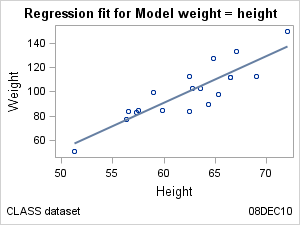Initializing Template Dynamics and Macro Variables
A useful technique for
generalizing templates is to define dynamics and/or macro variables
that resolve when the template is executed.
You can create new macro variables or use the automatic
macro variables that are defined in SAS, such as the system date and
time value (SYSDATE). Both types of macro variables must be declared
before they can be referenced. Whereas automatic macro variables do
not require initialization, you must initialize any macro variables
that you create with the variable declarations. The macro variable
values are obtained from the current symbol table (local or global),
so SAS resolves their values according to the context in which they
are used.
The following template
declares the dynamic variables XVAR and YVAR, and the macro variables
STUDY and SYSDATE:
proc template; define statgraph mygraphs.regfit; dynamic XVAR YVAR; mvar STUDY SYSDATE; begingraph; entrytitle "Regression fit for Model " YVAR " = " XVAR ; entryfootnote halign=left STUDY halign=right SYSDATE ; layout overlay; scatterplot X=XVAR Y=YVAR ; regressionplot X=XVAR Y=YVAR ; endlayout; endgraph; end; run;
As with all GTL templates, the MYGRAPHS.REGFIT template
can be executed with either a PROC SGRENDER statement or a DATA step.
Either way, any dynamics and/or new macro variables that are declared
in the template must be initialized to provide run-time values for
them. The following example executes the template with PROC SGRENDER:
%let study=CLASS dataset; proc sgrender data=sashelp.class template=mygraphs.regfit; dynamic xvar="height" yvar="weight"; run;
The DATA step uses the DYNAMIC= suboption of the ODS=
option to initialize dynamics. Macro variables can be initialized
from the existing symbol table. You can update the symbol table during
DATA step execution with a CALL SYMPUT or CALL SYMPUTX routine. The
following example executes the MYGRAPHS.REGFIT template with a DATA
step:
data _null_; if _n_=1 then call symput("study","CLASS dataset") ; set sashelp.class; file print ods=( template="mygraphs.regfit" dynamic=( xvar="height" yvar="weight" ) ); put _ods_; run;
For a more complete
discussion of this topic and additional examples, see Using Dynamics and Macro Variables to Make Flexible Templates.
